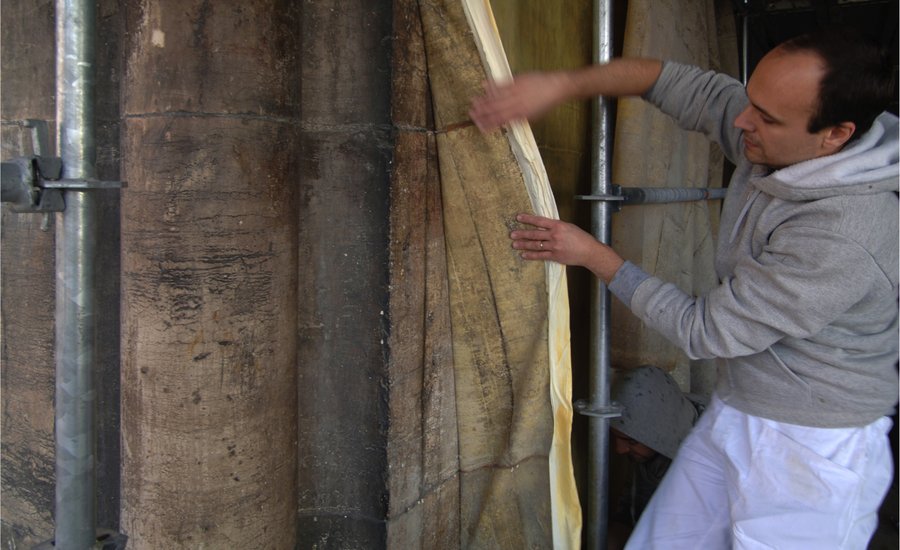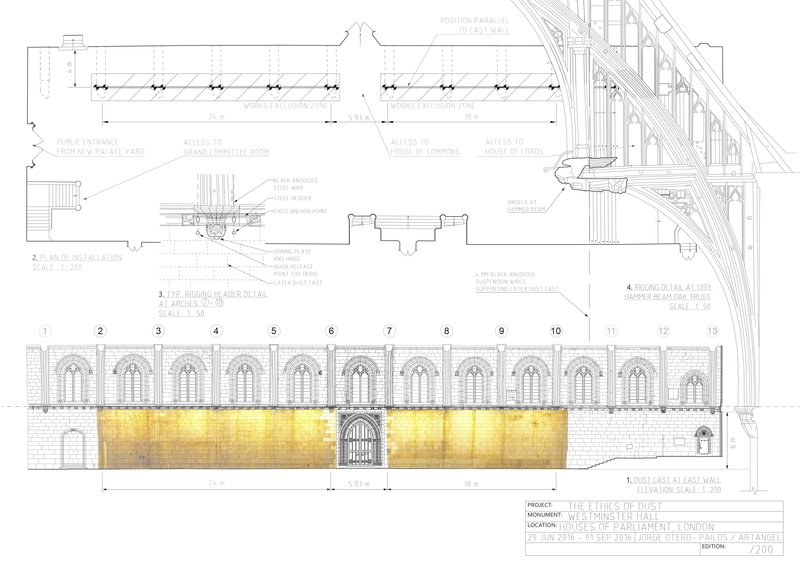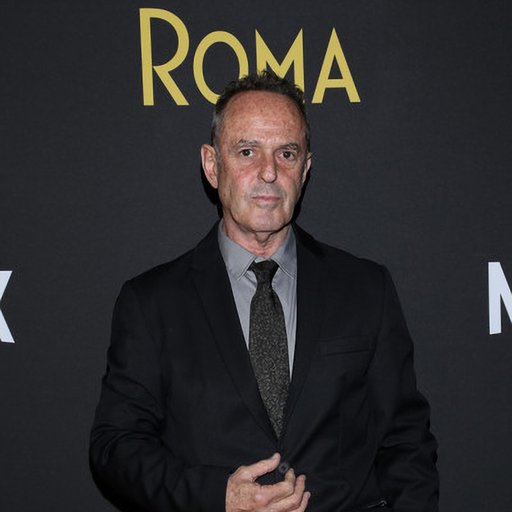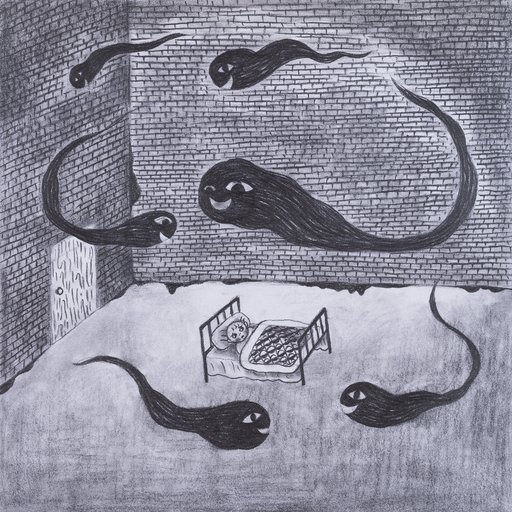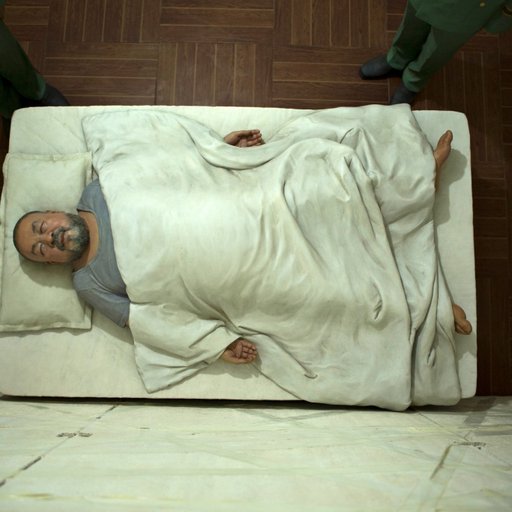Artist Jorge Otero-Pailos draws from his formal training as a preservationist to make atmospheric dust, soot, and other remnants of the built environment the subject of his work. Using liquid latex traditionally used to clean landmarked buildings, he creates skin-like surfaces that bring forth layers of history embedded in the stones of our cities, rendering visible what would otherwise stay hidden. With a current exhibition on view at the Whitworth Museum in Manchester, and a sound and sculpture installation up at New York City Center's Harkness Studio, the New York-based artist speaks with Artspace about his process.
How did you come across the latex casting technique you use?
I began to work in this technique in the process of cleaning buildings as an architectural preservationist. This is a technique developed very recently by a company in Belgium and I was one of the first to experiment with it. Basically, you apply a liquid on the wall, and it is designed to absorb all of the grime and soot off of the wall. The result is a clean wall, and all of the dust is transferred onto the latex. When the latex dries, it peels off like when you do a facial. You're just peeling the face layer off the building.
The result is a skin-like texture that has all of the building's impurities embedded within it. What is the result meaning-wise? What do these pieces communicate?
Globally all of these pieces together speak to the long history that is deposited on buildings over time. It's an environmental history because the dust comes from the air. The shared accumulation of our lives in buildings is really what fascinates me. How do we think collectively through buildings? How do we become a collective? Environmental history is very much related to that because I'm looking at buildings as long-term environmental sensors that receive this environmental information, which is this dust. This is not the personal dust of Man Ray and Duchamp, this is the Earth's environment now transformed from nature to culture. The sky is no longer natural; the sky is a cultural phenomenon. So I'm looking at the way in which that happened through deposits. There's no better place to look at these deposits than buildings. They've just been sitting out there.
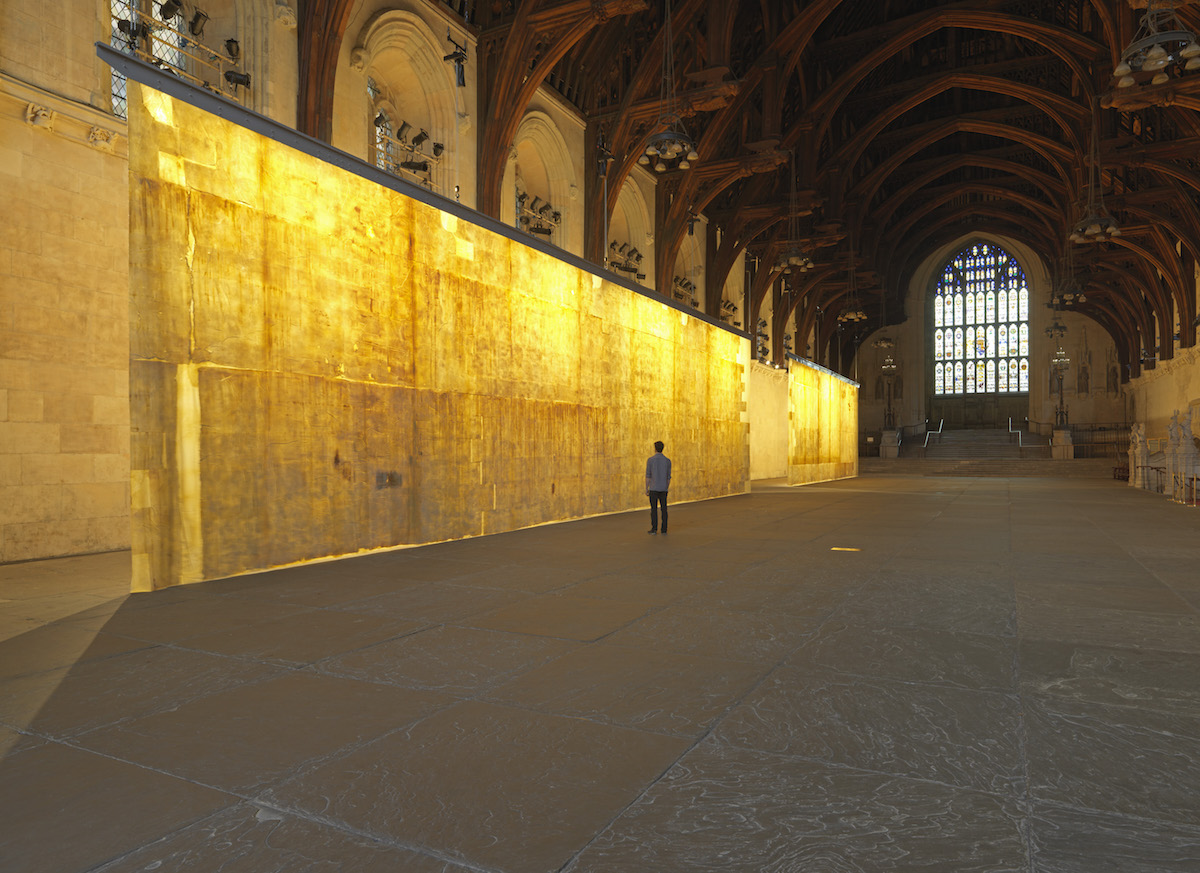 The Ethics of Dust: Westminster Hall
on view at the Westminster Hall London (2016). Photograph: Marcus J Leith
The Ethics of Dust: Westminster Hall
on view at the Westminster Hall London (2016). Photograph: Marcus J Leith
Can you tell me about the installation at the Whitworth Museum in Manchester?
The show at the Whitworth is a piece of the installation that I did in the UK Parliament in 2016. It became a very important piece because we opened the day of the Brexit vote. The piece was the background to the whole political stagecraft that happened right after, and it was divided up and distributed to various museums in the different nations of the UK. One went to the Whitworth Museum in Manchester and they brought it back because of the confluence of two events: The 28th of March was the deadline for finishing Brexit, basically, so the opening date was that date. It's also the 200th anniversary of the birth of [John] Ruskin, who has had a big influence on me. Ruskin brought together a lot of the things that I'm interested in. He was an artist himself, he was also very interested in preservation and was one of the people that began to argue that preservation needed to be a professional field and that we needed to take care of buildings in a different way, which was to not destroy them through unsympathetic transformations. He was against restoration.
The piece at the Whitworth is a cast of Westminster Hall. Do you know how old the dust and soot particles in that cast might be?
We can estimate by the date of the building's construction, and from records of any cleanings that would have happened. We know the dust from Westminster Hall could be from the 11th century, which is when the building was built. So almost one thousand years of dust. What we don't know is if it's been cleaned. We don't have any evidence of it having been cleaned, but I imagine that it must have been cleaned after the fire of 1834 when all of Parliament burnt down except for Westminster Hall. All of London came out to save Westminster Hall because it was so important to the city. It was a public space that held the Royal Courts, so you could go in at any time and see people getting judged. It was very important that those courts be public. This is speculation on my part, but I imagine that it was probably cleaned after that fire, but we don't know that for sure. All we know for certain is that it's at least 150 years of dust. If that's the case, 1834 to the present, then you have the history of industrial civilization. I'm very interested in industrialization, and the kind of life that we've worked up for ourselves throughout the last 200 years, the so-called industrial revolution.
Whether or not it was cleaned 150 years ago, I'm sure that it's accumulated the most grime during the last 200 years, right? The air is polluted now more than it's ever been.
That's right. Through my work I've come to learn that the Romans polluted the world's atmosphere. I did a work in a Roman silver mine in the southeast of Spain. Mining for silver makes a byproduct of lead, and lead isotopes can be traced back to the mine they came from. The lead from that particular mine is also found in the North Pole in a layer that is 2000 years old. So we know that the Roman's polluted the atmosphere. But what I'm very interested in is the fact that the Romans, at the height of their empire, had 70 million people and the average age was 18 years old. Now we have 7 billion people and the average lifespan is 65 or something like that. If you're talking about advanced economies you're talking about the average lifespan being in the 80s, 90s, or even 100s. So the scale is enormous now. I'm interested in visualizing the scale of pollution. We're so used to works of art as things that we can contain and put into our living room. I'm interested in expanding that to see if we can begin to grasp a longer scale—a building scale and then a planetary scale.
You exhibit these large latex casts that are as big as the walls that produced them. On Artspace, you have several small pieces that look as though they were produced by the same process. Do they all come from the same original large work?
You exhibit these large latex casts that are as big as the walls that produced them. But you also have several small pieces that look as though they were produced by the same process. Do they all come from the same original large work?
They're from different building sites. So as you say, after the big public art installation, which is usually ephemeral, I cut the work into pieces and then distribute them. Why do I do that? Because of two reasons. One is, that's what happens to very important buildings that we have attachments to. Think of the Berlin Wall, which has been cut into pieces and is now all over the world. But in our mind it's still the Berlin Wall; it still evokes the image of that building. And think of the Parthenon; actually a big chunk of the Parthenon is in London, there's pieces of it in the Vatican and in Copenhagen. The pyramids have been looted and taken to other places. When something is very important to us, we distribute it. It's almost as everybody wants to have a piece of it. That distribution I think is very interesting. So I do that with my works.
The other reason is because of this tension between the part and the whole that I think is really critical to re-conceptualize as an artist. What is the relationship between the different works of an artist? These works are both complete and local, and also part of a larger network of works. They're both wholes and parts of a whole. So when you're dealing with environmental pollution, if you have a bus stop right in front of your window, that's the whole problem for you. But it's also part of a larger problem which is the use of fossil fuels.
Also, since I'm very interested in environmental history, I'm very interested in our relationship to the sky. The sky is so big we actually can't see it all at once ever. Even the humans that have been in outer space and have looked back have only seen half of it because they're on one side of the planet. It is gigantic and it really requires an imaginative work to be able to think of the atmosphere. These distributed monuments are literally the atmosphere. They come from the sky, they're records of the atmosphere deposited. And the atmosphere deposits everywhere around the world. How do we imagine pollution as both a local and global reality? What is the future that this atmosphere is going to give us?
Do you see you work as activist?
That's a very good question. I'm trying to wrap my mind around the definition of activism: a call to action, something that actually makes you do something. I guess I'm a Ruskinian in that yes, there's always a call to action, but the first call to action is to observe reality. My activism isn't telling people what to do, or what the solution is. My activism is an activism of observation, of visual art. It invites you to look at the building next door, or the building your living in, and see that it's full of pollution and dust that comes from the sky. You might be moved to—not just clean the building—but to look at what your favorite politician's environmental policy might be.
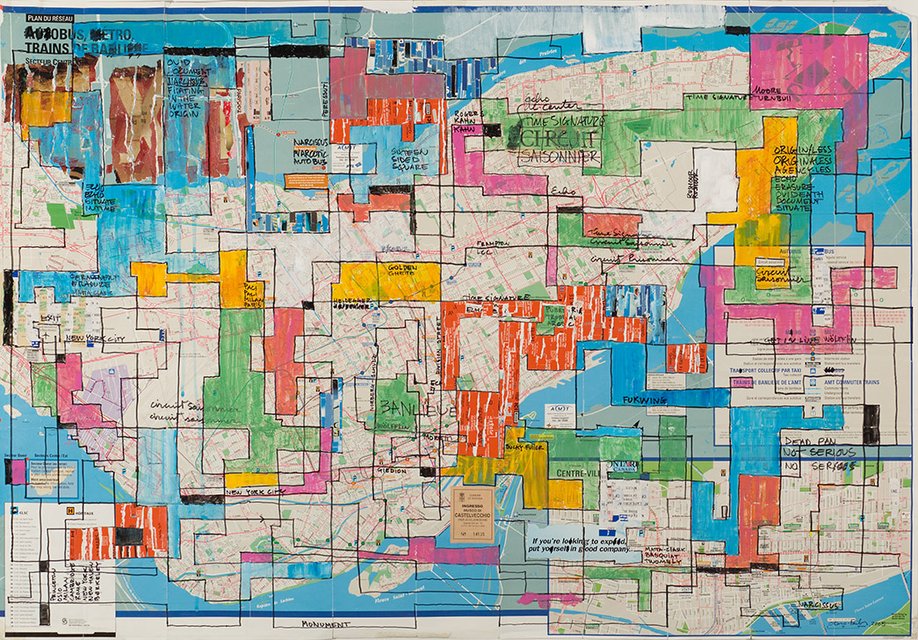 Continuous City - Montreal
is available on Artspace
Continuous City - Montreal
is available on Artspace
You have a few different bodies of works on Artspace. One is the Distributed Monuments, and one is the Continuous City works, where you've painted patterns over city maps. What can you tell me about this series?
These are pieces that are a reflection on what cities have become today. Cities are the major long-lasting monuments that we are collectively constructing together as a civilization. These pieces are drawn on historic maps, which I've been collecting over many years since the '90s. When I started collecting them, I didn't really know that they were going to disappear. It used to be that we all had one of these in our pockets but now we have it all in our phones. So these are historic documents in and of themselves. On one level I'm trying to show that the relationship to the world has changed, our relationship to the environment has changed. We no longer use these maps to move around. But secondly, I'm showing that the way we move around is as if we move in a continuous city. Most of us never get far beyond the city. We travel great distances on a plane from city to city but we are rarely ever not in a city. There's a narrowness of focus in our life, in our world experience, that on the one hand feels incredibly expansive (we are able to go everywhere relatively cheaply) and on the other hand we don't really get past the urban experience. With Continuous City, I treat all of these cities as one big city. It's related to the notion of Distributed Monuments in the way that it thinks about each of these cities as part of a global city, a massive urbanization of the planet. If you look around, most of what you will see is less than 50 years old. In the last 50 years we have exploded in terms of urban construction. The energy that we use and the pollution that we make to do that is the problem. As a preservationist, I know that our buildings are going to have to be rebuilt in the next 50 years because they're not built well and they're not going to last. And we don't have the energy to do that. We don't have the energy to rebuild our planet another time at the scale that we just did.
So it's as if these cities are connected and part of the same network and there's no outside to them. I'm very interested in how we get outside of them. How do we go from this city to that city? And then I start to transpose pieces of cities on top of other cities. So for example, I take the name of a neighborhood in New York and I name a neighborhood in Montreal the same way. Or I identify patterns. There's always a golden ghetto in a city, a place where all the rich are living. And it's very much a ghetto. So I try to call out places like this. I replan the city a bit and I'm trying to add a continuous aesthetic across all of these maps to link all of them together so that they read as one big city. There all in the same aesthetic whereas the original historic maps all look different.
Now, when you go look at a city, they all look the same because we all look at them through Google Maps. So in way these works already saw it coming. It's funny because these works are in between the moment in which every map from every city looked different and then the transformative moment of when they became the same. They're telling the story of when this transition happened. That's very much our moment, our lived experience. It's within your lifetime and my lifetime that that's happened.
You'll have an installation at New York City Center’s Harkness Studio opening April 29 . What can our readers expect to see when they go?
They will see a portrait of dance without dancers. They will see and hear (it's important that there's a sound element here) the labor of dance. It's so amazing: it takes 100 hours of practice to put together one minute of a dancer's time on the stage. That's just such an incredible amount of work. And what I'm interested in is the miracle that a dance survives from one generation to the next. Because you cannot just pick up a dance that hasn't been danced for three generations and redo it. Someone who has danced the dance has to teach you the dance. So it's a miracle that we have all dances among us because that means that there has been a chain of transmission from one dancer to the next to the next. That's what you're going to experience—Merce Cunningham and his students laboring passionately to transfer the knowledge from the master to the student, then the student to the student, and to the next generation in order to give you this fleeting moment.
In the exhibition there are casts of the walls of the dance studio, which I transferred with my technique. They have literally the skin of the dancers that they rubbed onto the walls while they were taking breaks. And then within that there is the sound of Merce Cunningham teaching his students. So you hear the bodies moving in space and the footwork. It's really something very special. I'm not a dancer so this has been transformative for me. It made me think of the intangible materials that go into an art. The way that art is about the labor that goes behind it but also the performance that goes into the work. In fact, what I'm interested in, is that it's so tied to the space in which they made the dance, to the architecture. You really understand where a dance comes from when you see where it was choreographed. You understand why dances in the Amazon involved gathering in a circle because there are no walls. And you understand why, in a room where there are three walls and a mirror, a dance gets organized in a different way. The place and architecture is so important. That's why these are casts of the architecture. And they're placed on the floor which is where the dancers are normally. The architecture takes the place of the dancers quite literally, so you get this magical transformation of a dancer into architecture.
It's actually been a really interesting direction for me because it's the first time I introduced sound in my work just as a way to measure time in a completely different way. When I work on a building that's 1,000 years old, I'm looking at geological time. Whereas with dance, I'm looking at the time of a butterfly. I'm looking at instant time, lived time. It's so short and yet it can take a lifetime to make something so short and to keep it alive. So I had to introduce a different measure of time: sound.
RELATED ARTICLES:
Location, Location, Location: Artist/Architect/Designer Jorge Pardo on Why Context Is King











